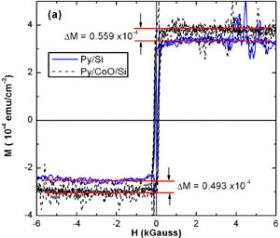Studying Magnetic Interface Ferromagnetism

The development of various magnetic-based devices, such as read-heads found inside your computer, depends on the discovery and improvement of new materials and magnetic effects.
In particular, researchers are interested in the magnetic behavior at the interfaces between different materials, especially in devices presenting so-called “exchange bias”– an effect produced by combining ferromagnetic and antiferromagnetic materials. Because these materials sometimes have very small magnetizations, characterizing them at atomic- and nanometer-length scales isn’t easy. However, using soft x-ray resonant magnetic scattering at the NSLS, a group of researchers has found a way to investigate how magnetism varies with the depth of a thin layer of material, specifically at the interface.
Many new state-of-the-art materials and devices for magnetic reading and writing rely on the interplay between different magnetic properties. This is especially true for quantum mechanical spins, the origin of the atoms’ magnetic behavior. In a ferromagnet, the atoms’ magnetic moments are aligned in parallel, whereas in an antiferromagnet, the moments are antiparallel. The coupling between an antiferromagnetic and a ferromagnetic material may give rise to exchange bias, which locks the ferromagnet spins (a major contributor to the magnetic moment). This effect is of fundamental importance to modern magnetic devices since it forms a reference layer with a fixed direction of magnetization.
This is not a new concept,” said lead researcher Sujoy Roy, from the University of California, San Diego. “It’s very important for technology and extensively used in spintronic-based devices.”
However, there are still ongoing controversies about the microscopic origin of exchange bias. Previous studies have revealed the existence of “unpinned spins” (spins in one direction not matched by an opposite spin and responding to applied field) at the antiferromagnetic interface. To examine how these spins are distributed and how they interact with the ferromagnetic spins across the interface, the researchers determined the depth dependence of the net magnetization in an exchange-biased sample consisting of permalloy, a nickel iron magnetic alloy (the ferromagnet) and cobalt oxide (the antiferomagnet). This was done at room temperature, where no “pinned” spins exist in the antiferromagnet and the exchange bias does not occur.
“Not many instruments can do this,” Roy said. “You can use microscopes to look at the surface of a material, but we wanted to scan the films from top to bottom, especially the interface.”
To do this, the researchers used x-ray reflectometry at NSLS beamline X13A and magnetometry at University of California, San Diego. These techniques allowed them to determine the distributions of free spins and of spin orientation, providing an atomic-level picture of the exchange bias mechanism.
“This was a very unique method,” Roy said. “We have been able to pinpoint exactly how the magnetism is varying as a function of depth in absolute units.”
The team found that a region at the permalloy/cobalt oxide interface is modified both chemically and magnetically. This modification is due to the formation of an oxide layer containing both cobalt and permalloy in between the bilayer. While there is no significant magnetization in the cobalt oxide, the temperature dependence of the interfacial layer’s net magnetization is different than the permalloy. Their results were published in the January 31, 2007 edition of Physical Review B.
The magnetization in this interfacial region, and how it interacts with the antiferromagnetic spins in the cobalt oxide at low temperatures, is expected to play a key role in determining the exchange bias properties of this bilayer. Future work will repeat the experiment at lower temperatures, where exchange bias develops in the sample, in order to determine how the interface properties change.
Other researchers include Cecilia Sánchez-Hanke and Chi-Chang Kao (NSLS); Sungkyun Park (Los Alamos National Laboratory and Korea Basic Science Institute); Mike Fitzsimmons (Los Alamos National Laboratory); Sunil Sinha (University of California, San Diego, and Los Alamos National Laboratory); Y. Tang, Jung-Il Hong, Xuerong Liu, M. Brian Maple, and Ami Berkowitz (University of California, San Diego); and David Smith (Arizona State University).
Source: by Kendra Snyder, National Synchrotron Light Source





















